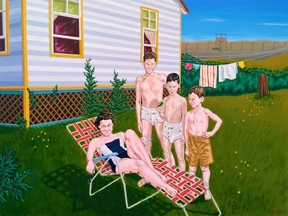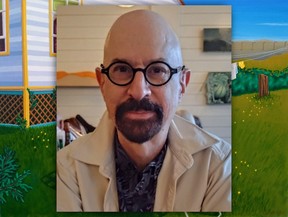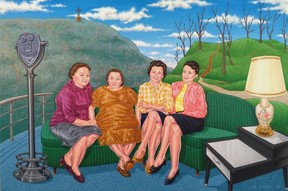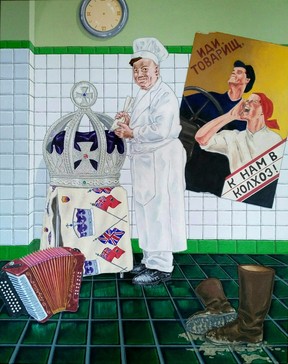“If I am real, it encourages others to reflect on their own reality, Arnie Lipsey says. His paintings are exhibited at the Museum of Jewish Montreal.

Article content
Artist Arnie Lipsey grew up in Côte-des-Neiges and Côte-St-Luc, the youngest of three sons of European Jewish immigrants who arrived in Montreal separately in the mid-1930s, met in 1941 and married in 1942.
Each of the 18 paintings in his solo exhibition at the Museum of Jewish Montreal, The Past Is Before You, draws on an archival family photograph and then branches out “to examine questions of identity, family history and the relationship between the personal and the universal,” as he put it.
Advertisement 2
Story continues below
Article content
It’s powerful stuff.
To museum executive director Zev Moses, Lipsey’s work is “an invitation for people of all backgrounds to imagine their own family story and to connect with the joys and traumas of their origins.”
As Lipsey, 71, said in an interview from Toronto, where he has lived for most of his adult life: “My work is very personal and specific to my own story and my own family but … it reflects a contention I have, an operating principle: If your work is personal but authentic and honest, even people who don’t share your background and story will recognize authenticity when they see it — and this will encourage them to reflect on their own families.
“If I am real, it encourages others to reflect on their own reality.”

His work has appeared in group shows and other juried exhibitions in Ontario and Florida, but The Past Is Before You marks his first solo exhibition — and his first show in his hometown.
Lipsey’s mother, who was from Lithuania, was one of three siblings. Her father left for Canada when she was an adolescent and nine years later, in 1936, the family was reunited in Montreal, where her parents had a fourth child, Lipsey’s Aunt Eleanor.
Article content
Advertisement 3
Story continues below
Article content
His father was from a shtetl in Poland and arrived in Montreal in 1935. He was sponsored by his older brother, who had arrived a decade earlier, and was the third — and last — of his eight siblings to leave their small Jewish village. His six younger sisters and his parents perished in the Holocaust.
“It was never presented as a schematic,” Lipsey said of his father’s story. “There were stories here and there. My dad found it difficult to talk about it until much later in his life. Friends of theirs had survived the (concentration) camps and had numbers on their arms.”
After graduating from the Montreal Museum of Fine Arts’ School of Art and Design, a private arts college where he majored in film animation, Lipsey worked in the fledgling Israeli animation industry and then moved to Toronto in 1978. He had a long career in animation for film and television and produced two animated short films but until his retirement in 2018, he painted only sporadically.
“Painting takes a certain kind of sustained concentration,” he said.
While still working in animation, he reimagined a couple of old black and white family photos as colour images. His sense of colour composition “comes from animation, which has a certain lexicon — taking real life and turning it into a cartoon,” he said.
Advertisement 4
Story continues below
Article content
Although he doesn’t paint photographically, he likes the spontaneity of brush work and said he knew he wanted to achieve a likeness.
Lipsey goes through family photos when looking for an idea for his next canvas, he said In describing his process.
“It takes a kind of free association to do something other than replicate. It is almost like being in a fugue state. An image kind of clicks with who the person is and where they are and what I want to say about them and their story. And when it clicks, I know to stick with it. And as I start painting, it is the painting itself that starts to explain things. And by the time I finish the process, I kind of understand what I have done.”
As exhibition curators Taryn Fleischmann and Austin Henderson observed, Lipsey’s compositions are dreamlike and “lie somewhere along the boundaries of fantasy and reality: saturated hues replace the black and white source material and figures are posed in the midst of often-surreal and multitemporal settings.”
Cottage Life, one of the 18 colourful acrylic canvases in the exhibition, draws on a photo of Lipsey as a boy, standing with his older brothers beside his Aunt Eleanor, who is lying in a webbed lounger. The foreground depicts a typical summer cottage scene in the Laurentians, complete with towels hanging on a clothesline, but just beyond the line is a barbed-wire fence and a guard tower.
Advertisement 5
Story continues below
Article content
“I was discreet with Holocaust references,” he said. “Is the fence keeping them in — or keeping them out? It’s an open question.”

The foreground of Look Out is based on a photo of Lipsey’s maternal grandmother and her three daughters taken in the basement of his family’s Côte-St-Luc home, where they are sitting together on a sofa. “It was a rare occasion to be together at one time and talking to each other,” he said. “In real life, they had a volatile relationship.”
Behind them is a railing.
“It’s a wonderful and evocative photo,” he said. “I thought of them against the railing of a lookout: On one side, there is Mount Royal in Montreal and, on the other, the Ukmergé mound, an old mound in (the shtetl of) Vilkomir, Lithuania, where my grandmother and mother came from. I started putting the trees up and intended to put leaves on them but, as I started, I stopped.”
To Lipsey, Look Out shows “the extent of their voyage from one world to another. It’s the story of their immigration, really.”

The Pastry Chef draws on a photograph of LIpsey’s maternal grandfather, who was a pastry chef at the Jewish General Hospital, with an elaborate cake he had prepared in honour of the 1937 coronation of King George VI.
Advertisement 6
Story continues below
Article content
“He was evidently very proud of that cake and it is pretty magnificent,” he said. “There is flour dust on his shoes: That was part of the original photograph. The other elements tell you more about him as a man.”
A Lenin-era agriprop poster about collective farming is a nod to the fact that his grandfather, from what Lipsey was told, was “a fairly radical left-wing guy, and it may have been part of why he left Lithuania: He was in imminent danger of being arrested.” He was also said to have gone AWOL from the army. Hence the muddy boots in the painting.
There’s an accordion at the base of the cake table. His grandfather played “and was very gregarious, a real performer and an amateur thespian,” said Lipsey.
He is smiling but it’s not an altogether open or happy smile.
An artist friend observed of the series: “‘These are portraits, but they are haunted.’
“That helps me to contextualize it,” Lipsey said. “There is something else going on — and that is what I am exploring.”
AT A GLANCE
On Thursday, Sept. 5 at 5 p.m., the curatorial team of the Museum of Jewish Montreal will give an hour-long guided exhibition tour of The Past Is Before You. The museum is at 5220 St-Laurent Blvd. Admission is free and the tour is open to all. Reserve here.
Regular museum hours are 10 a.m. to 5 p.m. Thursday through Sunday, and Monday till 4 p.m. Closed Tuesday and Wednesday. Suggested entry fee is $8, although tickets to the museum’s historical walking tours and food tour come with free admission to the exhibition. The Past Is Before You will remain up through Oct. 27 at least and possibly longer.
A price list for Lipsey’s paintings is at the museum; inquiries can be made to: ritavine@arnielipsey.com.
Recommended from Editorial
Advertisement 7
Story continues below
Article content
Article content


Comments